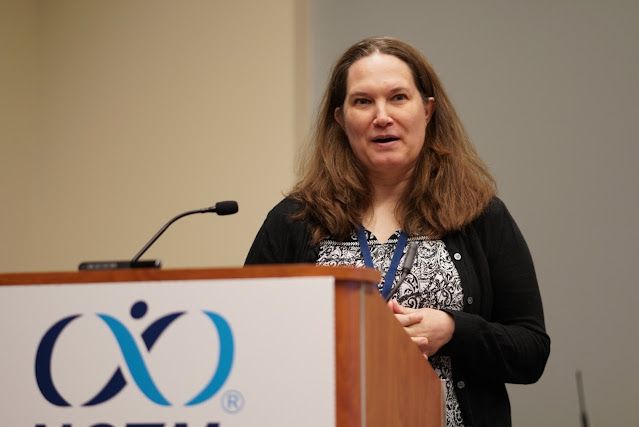Today started at 8 am and I snuck in a little late to see Charles Honensee and Sara Gartland of the University of Delaware present about backward transfer. It's an interesting phenomenon when something students learn later has an impact -- sometimes intentional, sometimes not, and sometimes negative -- on something learned earlier. They reported on a high school quadratics unit that was taught in such a way to improve earlier learning on linear functions, which was a nice result to see.
 |
| Sara Gartland |
I then went to a series of talks about language and discourse in secondary math. First, a group including Jonathan Foster, Laura Singletary, AnnaMarie Conner, and Hyejin Park (from a variety of universities) described a framework for describing displays. What's a display? It took me a moment to wrap my head around it, but it could be a lot of things, but in most classrooms you're thinking about how teachers and students use whiteboards, Smartboards, posters, and artifacts of student work to display information. I could kind of get a sense for how having a framework to describe these things could help future research studies organize some of their work.
 |
| Sarah Roberts |
Sarah Roberts of the University of Santa Barbara went next and talked about how to support teachers in including language routines into the curriculum that they develop and find when it isn't there already. With more than 70% of high school teachers reporting that they create their own materials on a nearly daily basis, this kind of work is needed in the secondary grades. The last presentation was from Madeleine Chowdhury from Mesa Community College, and she talked about the role of discourse she's observing in a research study with some of her students.
 |
| Madeleine Chowdhury |
I went to a research in progress session and heard from some folks from Cal State Sacramento who are working on some quantitative reasoning courses and research to support them. That went well with another researcher at the table, Veronica Cambra-Faraci, who is following up with and learning from former students who took Geometry and Algebra 2 together at the same time in her high school as a way of accelerating to calculus their senior year.
 |
| Kyndall Brown |
The plenary session was a combination of talks. First, Kyndall Brown from the California Mathematics Project talked about how research informed California's math frameworks.Next, Joleigh Honey from Utah talked about the importance of working across stakeholder groups to affect change in mathematics education. Lastly, and clearly the highlight of the day, was Rachel Lambert from The University of California, Santa Barbara. She's positioned herself and her work at the intersection of special education and mathematics education, and had A LOT of things to say about how these two worlds have traditionally been separated and the impacts it has on how we conduct and interpret research and, more importantly, what it does for the experiences of special education students in mathematics. This talk was well-timed with recent campaigns to come up with a "science of math" that seems to grossly misinterpret research to make claims about teaching all students. The talk wasn't really long enough to work patiently through all the details, but this is an important topic and I hope it encourages more researchers to work beyond those traditional boundaries to find consensus solutions.
In one final session, I joined five people from NC State who are working on a microcredentialing system. As the only participant in the session, I got all the attention I could have wanted, for sure. Sometimes that's just how conference sessions work out.
 |
| Jamila Dugan |
The NCTM Annual Meeting kicked off with the usual Wednesday night ceremonies, including recognizing the service of the NCTM Board, the program committee, the local hosting affiliates, and honoring the newest NCTM Lifetime Achievement Awardees. This year, that was Joan Ferrini-Mundy and Betty Phillips. I talked about Joan Ferrini-Mundy yesterday, and if you've ever used the Connected Mathematics Project (CMP) materials from Michigan State, then you've benefited directly from Betty Phillips's work. That was followed by the keynote address, delivered by Jamila Dugan, co-author of the book Street Data. She encouraged us to get past "traps and tropes" when talking about equity and listen more to the people and signals closest to our students, and better recognize how it can compliment and make up for the limitations of our larger-scale data collection, such as with state and national testing.